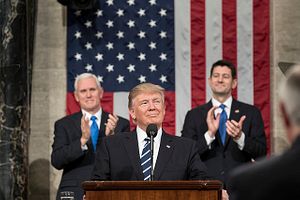U.S. President Donald Trump announced Monday that the United States and Mexico have reached a breakthrough on a deal that will resolve major issues in bilateral trade between the two countries. Canada, it is said, is welcome to join in if it likes; the ball is in their court.
The U.S.-Mexico deal announcement comes four days after Chinese negotiators left Washington with nothing in hand except their boarding passes.
There are pointers for China in the unexpected result of a U.S.-Mexico trade rapprochement. Many of these lessons should sound familiar to Chinese negotiators.
First, the trade deals that the Trump administration has targeted for renegotiation are, indeed, negotiable. It appears that decision-makers, including Trump himself, are committed to better terms for the United States, but are not taking tough and intractable positions toward trading relationships just for the sake of political bravado.
Indeed, there is every evidence of sincerity and good faith in the administration’s approach, a point missed by many, or deliberately ignored. The results suggest that revisiting and reworking the United States’ trading relationships to the greater benefit of Americans has not just been campaign rhetoric targeted at a certain sector of the population. It has been policy all along.
China should recognize that concept, as it is similar in style to its own approach. Chinese negotiations can be brutal, intense, and disconcerting. The tone of negotiations can go swiftly from dictatorial and aggressive to docile and accepting, and then back again. But China has for decades consistently shown that despite all of the bluster and bruising behavior, when Beijing sits down for negotiations, it intends to find a deal. Indeed, negotiations don’t even begin unless there is a policy and a plan behind them.
Second, the U.S.-Mexico deal illustrates that the United States is able to set the pace of negotiations, bide its time when it wants to, and then arrive at a lightning quick resolution when the terms are right.
To Chinese negotiators, controlling the clock of negotiations should look familiar. China has been exploiting timing and pace tactics of negotiations effectively for at least 30 years. It is common for Chinese negotiators to engage their counterparts in frenzied days and nights of talks, only to disappear and remain out of contact for weeks on end. That the tactic is rarely reciprocated is only because of a lack of will. That appears to be changing. Trump, referring to China in Monday’s announcement of the U.S.-Mexico deal, said, “They want to talk” — but “it’s just not the right time to talk right now, to be honest.”
The United States, by indicating that no timeline exists to come to a trade agreement with China, is therefore controlling the timing. China is unused to finding itself on the receiving end of this position, but understands its power nevertheless.
Third, the United States is not negotiating these deals defensively. In fact, bolstered by the often blunt and colorful language of the president, the U.S. position is designed to deliver a precise message to its trading partners: fair deal, or no deal. We are perfectly fine either way. In negotiating, this is a very difficult position to hold if, in fact, it’s a bluff. The trick is not blinking. So far, the United States appears to either genuinely hold the dominant position in trade negotiations, or it has bluffed but not blinked. Either way, results appear to be in the United States’ favor.
China has a record of excellence in using exactly this technique. With the world beating a path to its door, China has believed itself to be in the dominant negotiating position in most areas of trade and investment for at least 20 years. Prior to that, however, when it had little to offer except an inexpensive and tightly controlled labor force, China bluffed its way into being taken seriously as a trading partner and as a destination for foreign investment. Countries and companies, hungry for China’s market, wanted the relationship badly, and showed it, both in posture, and in acquiescence to Chinese terms.
Therefore China is unaccustomed these days to being challenged in its dominance at the negotiating table. Nonetheless, it could profit in future negotiations with the United States by appreciating, and even tacitly acknowledging, that the Americans are negotiating from a position of relative strength this time. Beijing could, if it tried, find a wry irony in that.
Overall, the surprising success of trade talks with Mexico should give the Chinese insight and perhaps even inspiration into the nature of an American negotiating table that looks little like previous iterations. At its head sits a U.S. president with an instinct for negotiations that the Chinese might find unnervingly close to their own. Thus, the roadmap is there if China chooses to read it. The problem for China is going to be that many of the old familiar roads have been closed, and the new ones are in uncharted territory.
































